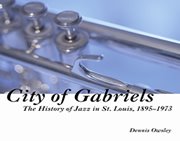
City of Gabriels: The History of Jazz in St. Louis, 1895-1973
By Dennis Owsley
Foreward by Clark Terry
Reedy Press
1-933370-04-1
No player in jazz has a happier tone than St. Louis native and Ellington alum Clark Terry. In writing the forward to Dennis Owsley’s City of Gabriels the jazz legend lends his considerable imprimatur to this history of jazz in the Gateway City.
Owsley argues that St. Louis’ position as a transportation hub precluded a development of its own style, because “as a river town and railroad center, influences have come and gone. No regional style of jazz has grown up here in contrast to Kansas City or Chicago.” (p. vii) However, St. Louis can claim a privileged place as the cradle of ragtime, as adopted home of Scott Joplin and Tom Turpin. Still, through the riverboat groups of Fate Marable, St. Louis musicians took a leading role spreading jazz up and down the Mississippi.
If the St. Louis area never developed a distinct regional style, it did give the world some of the great artists in the music’s history, including Frank Trumbauer, Jimmy Blanton, Clark Terry, Oliver Nelson, and Miles Davis. At one point Owsley relates six different stories on how Duke Ellington recruited Blanton for his band, many involve Duke pulling an overcoat over pajamas as he was dragged out to a club, where he was blown away by Blanton’s bass. No matter how it happened, Blanton went on to reinvent the role of the bassist in the Ellington Band, before his life was cut tragically short.
Along with Terry, Miles Davis is one of the most celebrated Gabriels from the St. Louis area. In fact, Davis looked up to Terry as a youthful musician. Terry relates blowing off the young Davis during a performance in a park, preferring girl watching to talking music. However, shortly thereafter Terry relates climbing the stairs to a jam session, where:
I heard this horn, which I hadn’t heard before, you know. He was wailing away. And I hurriedly got to the top and walked in, and looked to see this same little timid character with legs crossed, and he was blasting away. So I said, “Hey, man aren’t you the . . .” and he said, “Yeah, I’m the guy you fluffed off in Carbondale.” And we got a big laugh about it. We often laughed about that. (p. 84)
Not all the stories in Gabriels are pleasant, particularly those involving racial segregation. As usual, the segregated white musicians’ union did little to distinguish themselves. Local 2 was the white union “mainly concerned with concert bands, symphony orchestras, and theater pit bands” and Local 44 was the African American union which “played at parties, in some cabarets, and at dances.” There was an uneasy truce until jazz, the specialty of many artists in Local 44, became the popular music of the day, which was bad news for Local 2. As Owsley relates yet another ugly chapter in labor history:
Local 2 musicians began to form jazz groups. Members of Local 2 began a systematic campaign to stop white clubs from hiring black musicians. Because gangsters owned most of the clubs during prohibition, this strategy did not succeed. With the coming of talking pictures, white musicians playing in pit orchestras began to lose their jobs. Local 2 sought ways to revoke Local 44’s charter. (p. 48)
Gabriels is an attractive oversized tradepaperback richly illustrated with photos that capture the historic periods and artists under discussion. The only drawback is that Owsley’s text sometimes gets bogged down, compulsively listing the tunes and the largely unknown personnel which played on various St. Louis sessions. Overall though, it is a handsome book that well documents jazz in the Gateway City and persuasively advocates greater support for the St. Louis jazz scene.